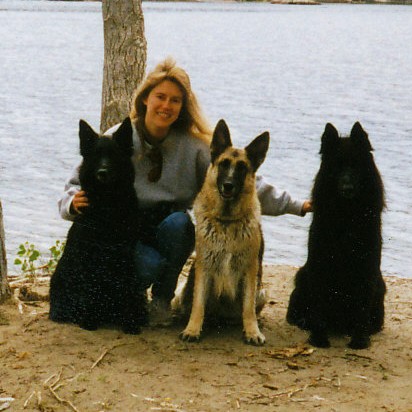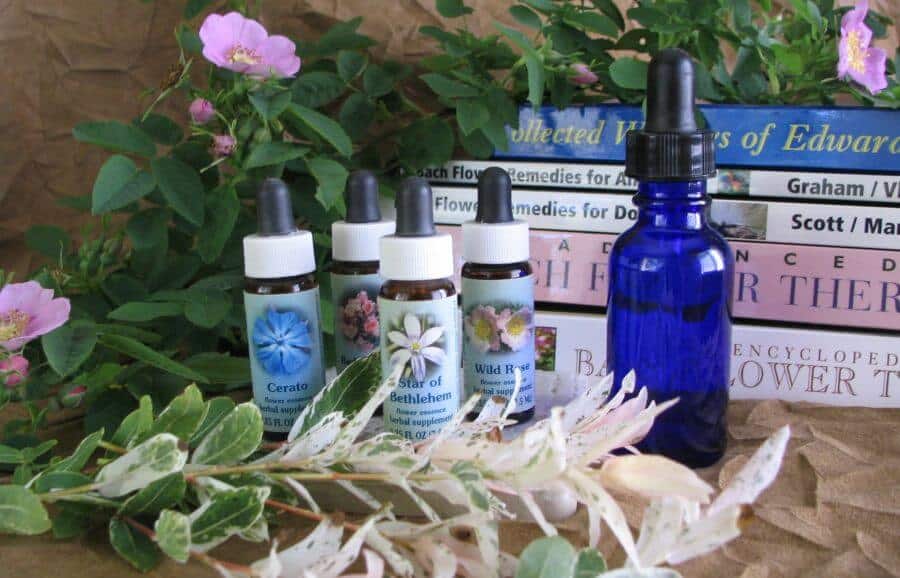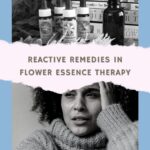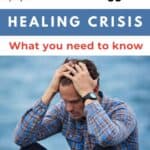Reactive remedies are flower essences that can trigger an emotional “cleanse†of sorts in the beginning stages of flower essence therapy. It’s a process that’s comparable to an aggravation in homeopathy or a healing crisis in naturopathy, except that in this case, the toxins being shed are emotional.
I’ve known for many years about Reactive Remedies in Bach flower therapy, and have seen the reaction many times myself. So I was surprised when I went to research this article, to find there is virtually nothing online about them. With one small exception, the information here comes from hard-copy resources <see end of article> and 25 years of Bach flower experience.
In this article, I attempt to answer all your questions (some you didn’t even know you had) about Reactive Remedies in flower essence therapy.
Why are some flower remedies reactive?
While flower essences are universally recognized as safe and gentle, certain essences can “release†emotions, particularly if those emotions have been pushed down and hidden away over a long time. I think of this as an “emotional detoxâ€.
To quote Jessica Bear PhD, ND, one of my favorite Bach flower writers, flower remedies “exchange fault (or negativity) for virtue. In some cases this exchange is not gentle or subtle, and many times this exchange releases volatile and explosive emotions.â€
Mechthild Scheffer, a European therapist who has written extensively (and brilliantly) on Bach flower therapy, doesn’t mention reactive remedies specifically but does discuss the healing crisis they can trigger.
Whether someone experiences a healing crisis is very individual, and depends on how long term the problem is, how resistant to change the person is, and how firmly the negative emotional pattern has taken hold.
Scheffer compares the healing crisis to what happens when a limb that’s numb or paralyzed begins to regain feeling. It hurts! Similarly, a long-suppressed traumatic memory (or even just an unpleasant one) is painful when it comes to mind. Suppressed pain can be emotional or physical. Just as we may see a physical healing crisis or “detox†when the body strengthens, we may see an emotional detox of sorts as the emotional self sheds harmful “psychological wasteâ€.
Human beings in general tend to repress or “stuff†unpleasant, painful, and even inconvenient emotions. Over time those emotions build up. When a process of healing and balancing begins, as happens with flower essences, those old, buried emotions will work their way out.
This release is not a side effect. It’s a clearing out, sweeping up, and good dusting which allows the individual to function once again on a healthier, more normal level.
Which Bach flower essences are considered reactive remedies?
Again citing the late Jessica Bear, there are 9 Bach flower essences considered to be Reactive Remedies:
- Agrimony
- Centaury
- Cherry Plum
- Crab apple
- Holly
- Impatiens
- Mustard
- Water Violet
- Willow
What kind of healing crisis does a reactive remedy trigger?
The actual reaction in a healing crisis will be influenced by a number of things. As you might expect, it will vary according to which essence triggers the reaction, since that will determine which type of emotional “gunk†is being cleared. Also, the buried emotions and overall emotional tendencies of the individual taking the essences will certainly affect how the reaction plays out.
In my experience, a verbal outburst is a common reaction. This will be something others wouldn’t expect from the person, since they’ve always pushed down or rejected that emotional reaction.
It could be a fit of crying, a bout of heartache or strong feeling of loss. It could be a strong emotional shift; a response or attitude you’re just not used to having.
To use the example of the Centaury flower essence. This essence helps balance the tendency to be everyone’s doormat. This is the person who will always say yes when asked, regardless of whether it’s convenient or even in their best interest. Someone of this character taking Centaury for the first time might have a reaction of suddenly, forcefully standing up for him or herself. S/he may even tell the person asking for yet another favor exactly what she thinks of him. This can be a shock for both people!

When does the reaction happen?
In my experience, a flower essence reaction tends to happen roughly three days after starting a new essence or essence combination. Obviously that’s very general, but is typical as far as what I’ve seen. If you were taking the essences on a less regular basis (i.e. not daily), or if you were only taking them minimally, such as once a day, I suspect the time frame of any reaction would be delayed.
How long does a healing crisis last?
The reactive, “crisis” stage from a reactive remedy typically lasts for seconds or minutes. My own personal experience has always been that they are quite short – under a minute. It’s over and done. That said, reports are that in some individuals the healing crisis can continue for a full day. I haven’t found any references to it lasting longer than that.
Will everyone taking a reactive flower remedy have a reaction?
No. When taking a Reactive Remedy, a reaction is not inevitable. It’s a possibility, however, and a real one. I don’t think anyone has data on how large a percentage of people have a reaction when they take a reactive remedy.
I think the reaction requires a certain degree of repressed emotion which not everyone will have. And the reaction itself will be very individual. In some people that do have a reaction, it might be quite mild, and not necessarily anything intense, explosive, or startling.
Can the emotionally reactive stage be prevented or minimized?
It’s hard to say if the reactive stage can be completely prevented. I suspect that if you begin taking a new flower essence very minimally, such as once a day and also keeping the essences to a minimum (taking one or two instead of six or seven at once), it might very well be possible to minimize any sudden release of emotion associated with the healing crisis. I don’t know that this is true as far as my personal experience, and I don’t find any documentation that this is the case, but it certainly seems like a real possibility.
Bear suggested that you may be able to shorten the reactive phase by increasing how often you take your remedy. I think we’d have to assume that this is going to increase the intensity of the reaction, however.
Another option, and this would be especially important if you’re really struggling with the reaction, is to reduce the frequency of how often you’re taking your flower essences until the crisis passes. Once you’ve leveled off emotionally, you can start again.
Bear also suggests taking Rescue Remedy for stress along with the Bach flower Gentian (for resilience and recovery from setbacks) when you’re having a reaction. Then the next day, begin again with your remedy at the normal frequency.
One thing I want to say is that having a reaction with a reactive remedy should not be seen as a negative. The very fact that there’s something in your emotions to cleanse and detoxify means that these things were lying there waiting to cause problems. So, it’s important to get unwanted, unhealthy emotions cleared out. To leave them there is only inviting further emotional distress and even physical illness (which is how Bach thought about his flower essences).
So, while having the reaction – whether it’s brief or a little more extended – take care of yourself, maybe back off a little bit on the formula until you’re feeling more yourself again, but I would suggest that you don’t give up on that formula.
If it happens, the reaction is a brief, often sudden, and fairly intense display of the emotions that have been buried. You might cry. You might swear. You might tell someone what you really think of them.
Will it be more than I can handle?
The idea of having an emotional healing crisis however brief can be scary. However, I have to say that in my own experience, I’ve never seen anyone have more of a crisis than they were able to handle. Scheffer also points out that, in her experience, there is an inner mechanism that prevents too much negativity from being cleansed at one time.
And since repressed emotions tend to build in layers, they are released in layers, too, which keeps us from being crushed by an avalanche of emotions, thank goodness!
It’s common to worry that the reaction may cause embarrassment, or worse. In my experience, emotional releases with flower remedies come at a time and place in which it’s safe for them to release. An example is a lady who attended a Bach flower class I taught some years back. She was a city bus driver, and was a little concerned that, if she had a reaction, she might blow up at some of her passengers. (Apparently this was an inclination she had to control on a daily basis!)
When I saw her the following week, she told me that she did indeed have a reaction and it did indeed wait until she was in a safe and private situation – at home with her family.
I believe that our subconscious, or sense of self-preservation, takes over when it comes to when and how emotional releases will happen. I have yet to know anyone who had any kind of dreadful release.
So, while it’s important not to stress over a potential reaction, I do suggest you plan ahead, prepare to be kind and forgiving with yourself, and if possible, tell people close to you. If you’re aware of having buried emotions, or some resentment or tension built up over the years, start the essences two or three days before the weekend or some other time when you can have a little privacy, or when you’re not overly pressured to “put on a good faceâ€.
You might want to avoid starting your new flower essence blend just prior to leaving for that week long business retreat with your new boss! Just be aware and plan accordingly.
Will reactive remedies trigger a crisis reaction every time they’re used?
If you revisit a formula with a reactive essence that you’ve used previously and had a reaction to, you’re unlikely to have another crisis reaction. Typically, true, cleansing-type reactions tend to occur only once for a given flower essence.
The only caveat I could think of would be if it’s been quite some period of time and you’ve reverted to your old emotional patterns. Then I’d think it would be possible. But even in that case, I suspect any reaction would be far milder than the first.
Now, if you take a new flower essence (or use a different system of essences), you may very well have another reaction. Having a reaction to one reactive remedy doesn’t preclude you from having a later reaction to another reactive remedy.

Can flower remedies for animals be reactive?
In 25 years of working with flower essences, including the last 10 years of working with many, many animals and flower essences, I have never found flower remedies to be reactive in animals. Why would this be? I think it’s because animals do not tend to stuff or repress their emotions. With animals what you see is what you get. That is, animals tend to be emotionally honest. So it seems very unlikely (and my own observations bear this out) that we would see detox reactions or crisis reactions with a dog, cat, or horse.
Now I did find one source that discusses reactive remedies in animals. This was on the Irish Retriever Rescue website. The writer on this page cites Impatiens as capable of triggering a release of pain if the animal has some sort of underlying pain or inner tension. She also says that Cherry Plum can cause a reaction of a slight loss of control in some animals.
I don’t doubt or dispute that this author is reporting what she observed. I can only say that it’s not something that I have seen in the years I’ve been working with flower essences and dogs. I’ve used Impatiens and Cherry Plum extensively in my animal formulas; they tend to be very important in a number of my blends. I don’t know how many dogs that were given Impatiens had any sort of underlying pain, so I can’t say for sure if it did have that effect or not. Cherry Plum also a very important remedy in my blends. Again, it’s my own personal experience but I’ve never seen any sort of reactive loss of control when using Cherry Plum.
However, I do think it’s something that will be interesting to keep an eye on, since more people are using flower essences for animals than ever before.
Do flower essence systems besides Bach’s have reactive remedies?
My main area of study and practice has been Bach flower essences. I’ve used North American flower essences, but have not studied them to any great degree. So it is not surprising that I’ve only come across reactive remedies within the Bach flower remedy system. I assume, though, that every system of flower essences has reactive remedies.
My one experience in having a reaction with non-Bach essences was with North American flower essences that I was taking myself. I have to say that the reaction was intense. This happened after years of using Bach flowers periodically. The North American essences I was using were ones I had never taken before. A few days into starting this new blend, I found myself heartbroken and sobbing one day – completely out of the blue. Nothing external had happened to trigger it; the only change was the essences. This was a very strong reaction, more intense than any I had ever had with Bach flowers.
It’s impossible to say, from that one experience, whether different systems may affect people differently insofar as how strongly they can pull out repressed emotions. It may have been that, or it could be that the emotions they released were so far buried that the crisis was necessarily severe. I can say that the reaction was, like others I’ve had, quite short, probably 10 minutes long. (Which was long enough, let me tell you!)
Conclusion
I hope this answers your questions about the role of reactive remedies in flower essence therapy. Flower remedies are such an amazing gift, and the occasional reactions triggered by reactive remedies are part of a benign and valuable process. Cleanses triggered by these safe, gentle tools help free us of harmful, buried emotions. And that, in turn, allows us to feel our emotions without being taken over by them.
Sources cited:
Practical Uses and Applications of the Bach Flower Essences, Jessica Bear PhD ND
The Encyclopedia of Bach Flower Therapy, Mechthild Scheffer

Julie Cantrell BSc is a professional dog trainer and canine behavior consultant who’s logged many thousands of hours training dogs and teaching owners since 1990. Flower essences have been part of her work with canine behavior since 1994. (bio)








